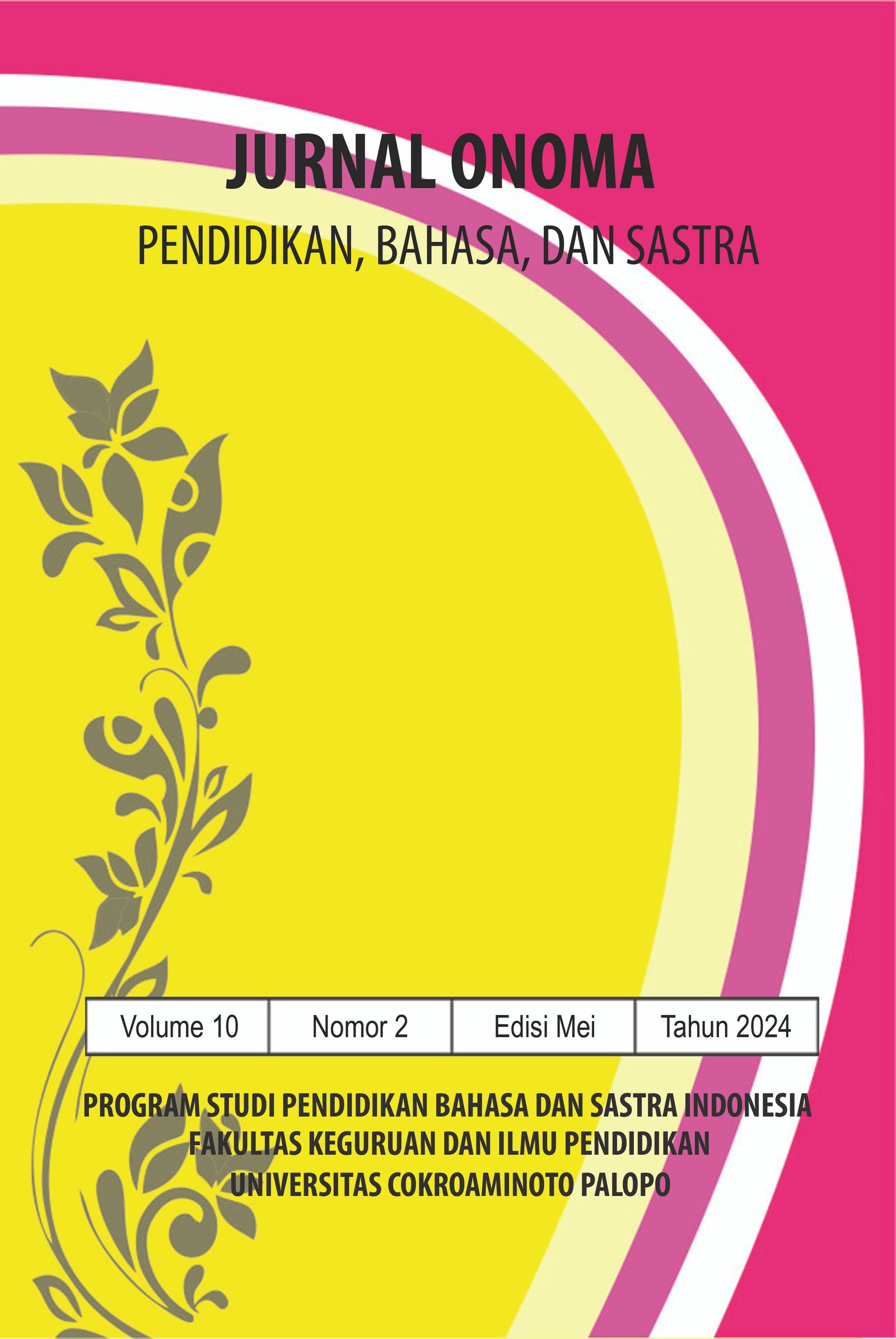Analisis Wacana Kritis Model Van Djik Pada Sambutan Joko Widodo pada Pembukaan Kongres XXIII PGRI Tahun 2024
https://doi.org/10.30605/onoma.v10i2.3582
Keywords:
Analisis, Wacana, Van DjikAbstract
Tujuan penelitian ini untuk mendeskripsikan struktur makro, superstruktur, dan struktur mikro teks berita web setkab.co.id. Metode yang digunakan adalah deskriptif kualitatif dengan pendekatan analisis wacana kritis model van Djik. Hasil analisis menunjukkan bagian makro struktur menggambarkan secara umum tema isu tentang kesempatan baik dalam dunia pendidikan agar jangan sampai terlewatkan oleh bangsa Indonesia. Bagian superstruktur skematik terdiri atas summary dan story yang menggambarkan upaya penulis untuk menampilkan efek tertentu. Bagian mikro struktur terdiri atas latar, detil, maksud, koherensi, koherensi pembeda, bentuk kalimat, kata ganti, leksikon, praanggapan, grafis, dan metafora .
Downloads
References
Brown, G., & Yule, G. (1983). Discourse Analysis. Cambridge University Press. DOI: https://doi.org/10.1017/CBO9780511805226
Eriyanto. (2006). Analisis Wacana Pengantar Analisis Teks Media. LKiS Tempo.
Eriyanto. (2011). Analisis Wacana: Pengantar Analisis Teks Media. Percetakan LkiS.
Ita Rosita, Dara Syahadah, Nuryeni Nuryeni, Hajjah Muawanah, & Yustina Sari. (2022). Analisis Wacana Kohesi Gramatikal Referensi Endofora Dalam Sebuah Cerpen “Aku Cinta Ummi Karena Allah” Karya Jenny Ervina. Prosiding Seminar Nasional Pendidikan, Bahasa, Sastra, Seni, Dan Budaya, 1(1), 179–191. https://doi.org/10.55606/mateandrau.v1i1.170 DOI: https://doi.org/10.55606/mateandrau.v1i1.170
Kartikasari, S. (2020). Analisis Wacana Kritis Nourman Fairclough Terhadap Pemberitaan Jokowi Naikkan Iuran Bpjs Di Tengah Pandemi. Jurnal An-Nida, 12.
Megawati, E. (2021). Analisis Wacana Kritis Model Fairclough Dan Wodak Pada Pidato Prabowo (Critical Discourse Analysis of Fairclough’ and Wodak’s Model Within Prabowo’s Speech). Kandai, 17(1), 75. https://doi.org/10.26499/jk.v17i1.1551 DOI: https://doi.org/10.26499/jk.v17i1.1551
Moleong, L. J. (2014). Metodologi Penelitian Kualitatif. PT Remaja Rosdakarya.
Mulyana. (2007). Metode Menulis Kreatif. CV Mandar Majurotok.
Ramdhan, M. (2021). Metode Penelitian. Cipta Media Nusantara.
SAKKA, S. BIN, Nurhadi, N., & Sari, E. S. (2023). Analisis Wacana Kritis Model Teun A. Van Dijk Pada Pidato Presiden Di Ktt Ke-42 Asean. Cendekia: Jurnal Ilmu Pengetahuan, 3(2), 93–102. https://doi.org/10.51878/cendekia.v3i2.2237 DOI: https://doi.org/10.51878/cendekia.v3i2.2237
Silaswati, D. (2019). Analisis Wacana Kritis Dalam Pengkajian Wacana. Metamorfosis | Jurnal Bahasa, Sastra Indonesia Dan Pengajarannya, 12(1), 1–10. https://doi.org/10.55222/metamorfosis.v12i1.124 DOI: https://doi.org/10.55222/metamorfosis.v12i1.124
Stubbs, M. (1983). Discourse Analysis: The Sosiolinguistik Analysis Of Natural Language. Basil Blackwell.
Sugiyono. (2016). Metode Penelitian Pendidikan Pendekatan Kualitatif dan R&D. Alfabeta.
Suharya, S. dkk. (2021). Analisis Wacana Kritis Teks Pidato Presiden Republik Indonesia Ir. Joko Widodo. Bindo Sastra, 5.
Suparman, S., & Nuruahmad, M. (2023). Budaya Mappacci dan Rangkaian Pelaksanaan Perkawinan Orang Bugis. DEIKTIS: Jurnal Pendidikan Bahasa dan Sastra, 3(4), 219-225. DOI: https://doi.org/10.53769/deiktis.v3i4.559
Swara Gema Ramadhan, & Gallant Karunia Assidik. (2022). Analisiss Wacana Kritis Model Teun A. Van Djik pada Pidato Menteri Pendidikan dan Kebudayaan dalam Rangka Hari Pendidikan Nasional 2020. Jurnal Onoma: Pendidikan, Bahasa, Dan Sastra, 8(1), 22–39. https://doi.org/10.30605/onoma.v8i1.1507 DOI: https://doi.org/10.30605/onoma.v8i1.1507
Downloads
Published
How to Cite
License
In submitting the manuscript to the journal, the authors certify that:
- They are authorized by their co-authors to enter into these arrangements.
- The work described has not been formally published before, except in the form of an abstract or as part of a published lecture, review, thesis, or overlay journal.
- That it is not under consideration for publication elsewhere,
- That its publication has been approved by all the author(s) and by the responsible authorities – tacitly or explicitly – of the institutes where the work has been carried out.
- They secure the right to reproduce any material that has already been published or copyrighted elsewhere.
- They agree to the following license and copyright agreement.
License and Copyright Agreement
Authors who publish with Onoma Journal: Education, Languages??, and Literature agree to the following terms:
- Authors retain copyright and grant the journal right of first publication with the work simultaneously licensed under Creative Commons Attribution License (CC BY 4.0) that allows others to share the work with an acknowledgment of the work's authorship and initial publication in this journal.
- Authors are able to enter into separate, additional contractual arrangements for the non-exclusive distribution of the journal's published version of the work (e.g., post it to an institutional repository or publish it in a book), with an acknowledgment of its initial publication in this journal.
- Authors are permitted and encouraged to post their work online (e.g., in institutional repositories or on their website) prior to and during the submission process, as it can lead to productive exchanges, as well as earlier and greater citation of published work.

















